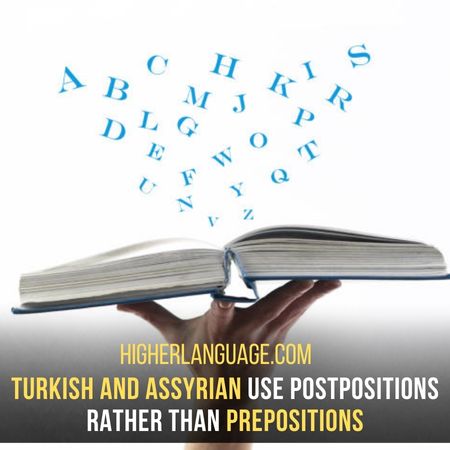Assyrian is a famous language and there are many languages similar to Assyrian. These languages include Arabic, Turkish, Kurdish, Syriac, and Persian.
[toc]
If you want to learn a language like Assyrian or join the community, these languages may be perfect for you!
Languages Similar To Assyrian – Top 9 Languages!
People learn a second language for different reasons. For example, some people learn it to communicate with people who speak another language.
Others learn a second language to travel and explore new cultures.
Some learn because they are interested in the language’s grammar or structure.
Whatever your reason for learning a second language, you should know that there are languages similar to every other language.
Knowing similar languages can help you in mastering the language you want to learn. The same goes for the Assyrian language.
If you want to learn Assyrian or other languages similar to Assyrian, you should be aware of the options.
Assyrian language is a branch of the Semitic languages. So, the other Semitic family language will be closer to Assyrian.

Conversely, learning one can establish your grip on other similar languages.
Let’s start finding languages similar to Assyrian. It will help you make wise decisions while learning a new language.
1. Arabic:
Arabic is one of the close languages to Assyrian. Like, the grammar of both languages are quite similar.
In both languages, there are three grammatical genders (masculine, feminine, and neuter). Also, both has two states (indefinite and definite).
Too, vocabulary-wise, the language has a great influence of Arabic. For example, many religious terms in Assyrian come from Arabic.
For example, “Eaman” (faith), “Islam” (submission), and “Injeel” (Gospel) have Arabic origins.
Another similarity between these languages is that they both use root systems. This means that most of the words in these languages depend on 3-letter roots.
These roots are then modified to create new words. For example, the root “K-T-B” in Arabic can create words like “Kitab” (book), “Kataba” (he wrote), and “Maktab” (office).
Similarly, the root “S-R-R” in Assyrian creates “Sarra” (head), “Sirru” (secret), and “Masaru” (to return).
So, if you know the roots, it’ll be easier for you to pick up new words in either language.
2. Hebrew:
When discussing languages similar to Assyrian, it is important to consider Hebrew. Both are Semitic languages, and they share many common features.
These two languages rely on tri-consonantal roots. This shows most words consist of three consonants, with vowels appearing in between.
For instance, “son” in Hebrew is “ben”. The root of this word is “bn”, with the vowels appearing between the consonants.
Similarly, in Assyrian, the word for “son” is “beana”. The root of this word is “bn”, with the vowels appearing between the consonants.
In addition, Hebrew is also written from right to left, like Assyrian.

Further, both have a similar sound system. For instance, both have glottal stops, such as the “kh” sound in Hebrew and the “ḫ” sound in Assyrian.
Finally, they are mainly used as liturgical languages by Jewish communities worldwide. So, they mainly serve for religious purposes, such as in prayer or study.
3. Syriac:
The Syriac language is similar to Assyrian in several ways. Firstly, it is written in a script called “Estrangelo,” derived from the Assyrian script.
Secondly, like Assyrian, its writing style goes from right to left. Thirdly, the two languages have a similar sound system, with both having glottal stops.
For example, in Syriac and Assyrian, the letter “alap” has a glottal stop. (Gutter stop means the airflow is completely blocked off for certain sounds, i.e., sound in “uh-oh” ).
Fourthly, Syriac and Assyrian languages have similar morphology. This means that they have common features in their grammar and sentence structure.
For instance, both languages use the same system of tenses (past, present, future). Further, they both have participles (verbs that can function as adjectives).
Finally, they are liturgical languages for their respective communities (Jewish and Christian). All these reasons make Syriac languages very close to Assyrian.
4. Amharic:
Amharic is the official language of Ethiopia. It is also a similar language to Assyrian.
Like Assyrian, Amharic has a triliteral root system. This means words are typically formed by combining three consonants (called “radicals”).
For example, the Amharic word for “book” is sefer, composed of the radicals s-f-r. The radicals-f-r originally meant “to count”.
While the other two radicals ( -f- and -r-) provided grammatical information. Both languages have this principle.
Another similarity is that both use suffixes to denote a function, such as case endings.
For instance, the word for “cat,” qot, takes the suffix -a when it is the subject of a sentence, as in qot-a “the cat eats.”
Finally, both languages have a rich tradition of poetry and literature. So we can say that Amharic is also very close to Assyrian.
5. Turkish:
Turkish is another language that shares similarities with Assyrian. Like Assyrian, Turkish is a Turkic language.
This means it is distantly related to languages like Azerbaijani and Uzbek.
Turkish also has SOV word order, like Assyrian. Additionally, both languages use agglutination to form words and phrases.
This means words are typically composed of a root plus one or more suffixes.
For example, the word for “cat,” kedi, takes the suffix -ler when it becomes plural, as in kedi-ler “cats.” And in Assyrian, the plural suffix for “qat” (cat) is -u, so the word would be qatu (cats).
Moreover, Assyrian and Turkish employ vowel harmony. This means that words must use either all front vowels (e, i, ö, ü) or all back vowel (a, ı, o, u), but not a mix of the two.
In addition, both languages have some similarities in their grammar. Like, languages use postpositions rather than prepositions.

An example is, rather than saying “in the house,” one would say “house-in.” Thus, we can see that Turkish is another option close to Assyrian.
6. Kurdish:
There are many commonalities between Assyrian and Kurdish. First, both languages have a common order, i.e., subject-object-verb word order.
Assyrian and Kurdish also share some common vocabulary words. For example, the word for “book” in Assyrian is “sepa”, while in Kurdish, it is “cep”.
Some of the other similarities include the vowel harmony and Agglutinative rules. Vowel harmony is when languages have restrictions on which vowels should come together.
For instance, in languages with vowel harmony, you can’t have a word that has both the vowels “a” and “i” in it.
Also, agglutinative languages add affixes, or small meaningful units, to root words. This changes the meaning or function of the word.
For example, the word “walk” in English can become “walks,” “walked,” or “walking” by adding affixes. These two also share this linguistic feature due to their shared heritage.
So, if you know some Assyrian, you’ll have a head start on learning Kurdish!
7. Persian:
Persian is another language that is very similar to Assyrian. In fact, the two languages share a lot of common vocabulary words.
For example, the word for “book” in Persian is “ketab,” which is very similar to the Assyrian word “ktobo.”
Persian also uses the same alphabet as Assyrian. This shows if you know how to read and write one language, you’ll be able to do the same for the other.
Additionally, Persian has a lot of loanwords from Arabic, just as Assyrian does. Such as the word “salam,” which means “hello” or “peace.” So both languages have the influence of Arabic.
Further, Persian is also an Indo-Iranian language. So it shares many grammar features with Assyrian. For instance, both languages use postpositions instead of prepositions.
So, if you know some Persian, you’ll also be able to understand Assyrian quite easily.
8. Sumerian:
Sumerian is another ancient language that is closely related to Assyrian. In fact, many scholars believe that the two languages have a common ancestor.
Sumerian was the language of the ancient Sumerian civilization. The civilization existed in Mesopotamia (the same region as Assyria).
The two languages share a lot of similarities, such as a common writing system (cuneiform).
Additionally, Sumerian have many loanwords from Akkadian, just as Assyrian does. For example, the word for “king” in Sumerian is actually derived from the Akkadian word for “king”.

If you know Assyrian, you’ll also be able to understand Sumerian quite easily.
Many of the same words are present in both languages, and the grammar is very similar. So both languages influence each other.
Further, Sumerian is also an ancient Mesopotamian language. That’s why people can also understand some Akkadian words.
Additionally, since Sumerian existed in Mesopotamia, you’ll be familiar with some place’s names.
9. Akkadian:
Akkadian is a Semitic language and the ancestor of Arabic and Hebrew. It was the language of the Babylonians and Assyrians.
If you know Assyrian, you’ll be able to understand Akkadian quite easily.
People of the language consider Akkadian to be a similar language to Assyrian. This is because they both come from the same family of languages, Semitic languages.
The Akkadian language was spoken in Mesopotamia, just like Assyrian and Sumerian. In fact, the word “Akkadian” comes from the city of Akkad, which was in Mesopotamia.
The two languages are very similar and share a lot of common vocabulary.
For instance, the word for “father” in Akkadian is “abba”, while the word for “father” in Assyrian is “Abu”.
There are also many grammatical similarities between the two languages.
For example, both languages use the same word order. Also, they have a conjugation system (changing the form of a verb to indicate tense, mood, etc.)
So, if you’re looking for languages similar to Assyrian, Akkadian is a good option.
Conclusion:
People who want to learn Assyrian must be aware of languages similar to Assyrian. This will give them a better understanding of the language and its grammar.
There are many languages that share similarities with Assyrian. For example, Arabic, Hebrew, Turkish and Persian are famous ones.
We are sharing nine languages similar to Assyrian. Knowing one will help you in learning another.
So, what are you waiting for? Start learning a new language today!